- 添加更多的view
- 写actually有用的view
- 使用模版来设计view
- 使用模版设计view的捷径:render()
- 抛出异常404
- 抛出异常404-快捷方法: get_object_or_404()
- 修改URL硬编码
- URL命名空间
view : Django应用(作为一个特殊的功能或者有一个特定的模版)里的一种网页.
在DemoAppPoll里,我们下面的view:
-
Question index page -->展示最新的问题
-
Question detail page -->展示一个问题和一个投票表格
-
Question result page --> 展示特定问题的投票结果
-
Vote action --> 处理特定问题的投票.
在Django里,每一个view都代表一个python 函数/方法.
请求一个url的时候,Django就会使用一个view来处理这个page.
从URL传递到view,Django使用URLconfs
第一个view
1.修改DemoAppPoll/views.py:
from django.shortcuts import render
from django.http import HttpResponse
def index(request):
return HttpResponse("Hello,urmyfatih.")
2.创建DemoAppPoll/urls.py
from django.conf.urls import patterns,url
from DemoAppPoll imoprt views
urlpatterns =patterns(
'',
url(r'^$',views.index,name='index')
)
3.在工程demoSite/urls.py中添加应用DemoAppPoll的urls.py
from django.conf.urls import patterns, include, url
from django.contrib import admin
urlpatterns = patterns('',
# Examples:
# url(r'^$', 'demoSite.views.home', name='home'),
# url(r'^blog/', include('blog.urls')),
url(r'^DemoAppPoll/', include('DemoAppPoll.urls')),
url(r'^admin/', include(admin.site.urls)),
)
url(r'^DemoAppPoll/', include('DemoAppPoll.urls')),就是我们新增的.
表示,我们使用DemoAppPoll.urls来处理http://localhost:8080/DemoAppPoll/的请求.
在DemoAppPoll.urls里,我们绑定了views.index来处理请求.
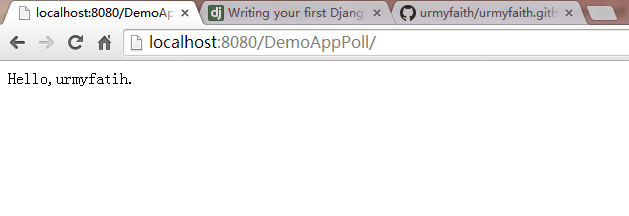
-
url()参数:regex
python将url请求在工程里urls.py中的pattterns列表中一一匹配.
并且这种匹配不会匹配请求的参数.即http://www.example.com/myapp/?name=zx仅会匹配myapp/ -
url()参数:view
匹配到正则表达式之后,调用特定的view函数. -
url()参数:kwargs
任意的关键字参数,可以通过字典传递给特定的view. -
url()参数:name
给url命名,这样就可以全局使用.
添加更多的view
DemoAppPoll/urls.py
from django.conf.urls import patterns,url
from DemoAppPoll import views
urlpatterns = patterns('',
url(r'^$', views.index, name='index'),
url(r'^(?P<question_id>d+)/$', views.detail, name='detail'),
url(r'^(?P<question_id>d+)/results/$', views.results, name='results'),
url(r'^(?P<question_id>d+)/vote/$', views.vote, name='vote'),
)
指定类/方法/函数来处理匹配到url:
views.index -->处理/DemoAppPoll/
views.detail-->处理/DemoAppPoll/[number]/
view.results-->处理/DemoAppPoll/[number]/results/
views.vote -->处理/DemoAppPoll/[number]/vote/
下面的是类/方法/函数具体如何响应请求的:
DemoAppPoll/views.py:
from django.shortcuts import render
from django.http import HttpResponse
def index(request):
return HttpResponse("Hello,urmyfatih.")
def detail(request, question_id):
return HttpResponse("You're looking at question %s." % question_id)
def results(request, question_id):
response = "You're looking at the results of question %s."
return HttpResponse(response % question_id)
def vote(request, question_id):
return HttpResponse("You're voting on question %s." % question_id)
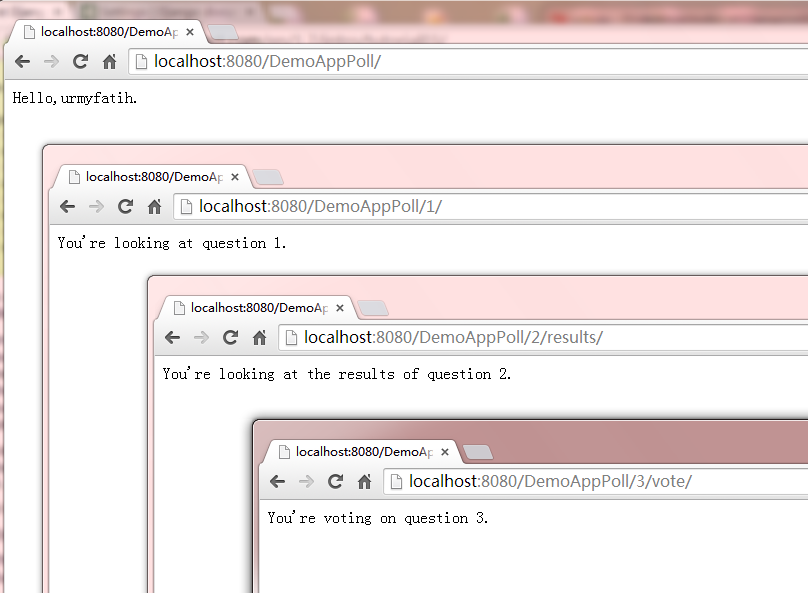
当请求http://localhost:8080/DemoAppPoll/33/的时候,
第一步:Django加载项目下的urls.py模块,即(demoSite.urls),从demoSite/urls.py中找到代表匹配列表的变量:urlpatterns,从列表中匹配.
url(r'^DemoAppPoll/', include('DemoAppPoll.urls')),
此时,匹配到DemoAppPoll/,
当Django遇到include()的时候,截掉已经匹配到的(DemoAppPoll/),将剩余的(33/)传递到URLconf继续处理.
第二步:Django截掉前面的之后,剩下的(33/),使用DemoAppPoll.urls模块(DemoAppPoll/urls.py)来处理.
url(r'^(?P<question_id>d+)/$', views.detail, name='detail'),
此时,匹配到view.detail,
第三步:由view.detail(DemoAppPoll/views.py中detail函数)响应请求.
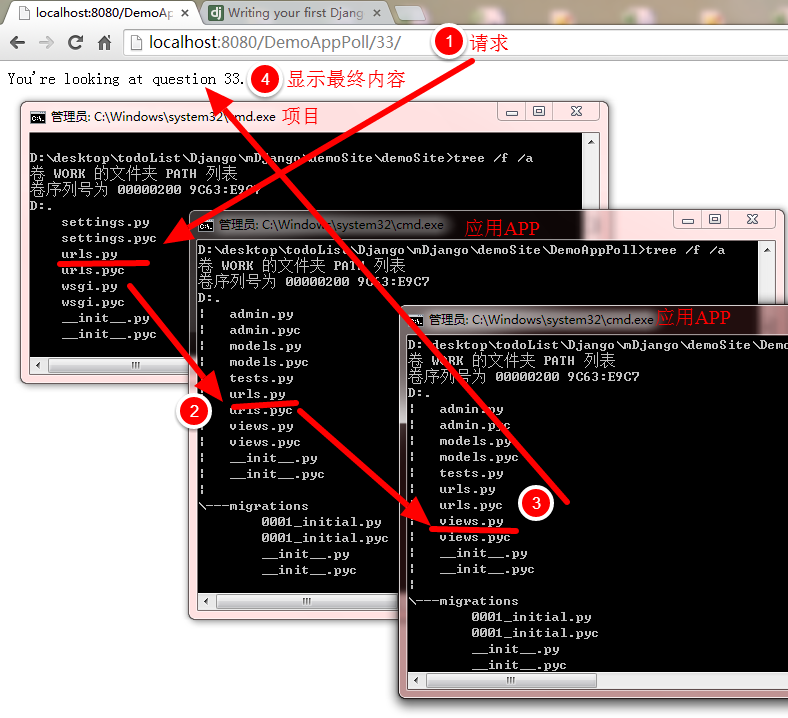
写actually有用的view
每一个view做2件事情:
- 返回HttpResponse(它包含了真实的html内容.)
- 抛出一个异常,例如Http404
其他的事情就是自己安排了,例如,利用Django的数据库API,显示最新的5条问题:
#in DemoAppPoll/views.py/[fun]index
from DemoAppPoll.models import Question
def index(request):
# IMPORTANT: read db , order , limit
latest_question_list = Question.objects.order_by('-pub_date')[:5]
# format question for output.
output=','.join([p.question_text for p in latest_question_list])
return HttpResponse(output)
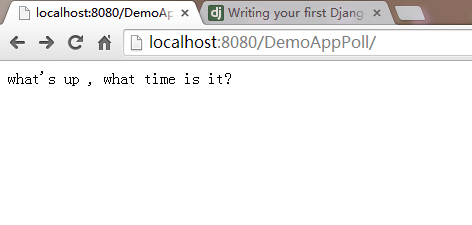
有个问题是,这个页面看起来是如此的简陋,这时候,可以使用template来设计.
另外一个问题是,template的位置放在哪里?
Django的TEMPLATE_LOADER设置包含了从哪里获得模版.
它的默认值有两个.
TEMPLATE_LOADERS
Default:
('django.template.loaders.filesystem.Loader',
'django.template.loaders.app_directories.Loader')
其中一个是app的,它在INSTALLED_APP的目录下查找templates目录.
使用模版来设计view
1th. 在App(DemoAppPoll)目录下,创建templates目录.
2th. 在templates目录下创建App名称(DemoAppPoll)的目录.
3th. 在DemoAppPoll目录下,创建index.html.
D:desktop odoListDjangomDjangodemoSiteDemoAppPoll>tree /f /a
| admin.py
| admin.pyc
| models.py
| models.pyc
| tests.py
| urls.py
| urls.pyc
| views.py
| views.pyc
| __init__.py
| __init__.pyc
|
+---migrations
| 0001_initial.py
| 0001_initial.pyc
| __init__.py
| __init__.pyc
|
---templates
---DemoAppPoll
index.html
这样,我们就可以是使用DemoAppPoll/index.html来设计view了.
4th. 修改index.html
使用for循环创建无序列表.
{% if latest_question_list %} 这是代表使用python语句.
{{ question.id }}代表使用python变量.
{% if latest_question_list %}
<ul>
{% for question in latest_question_list %}
<li><a href="/DemoAppPoll/{{ question.id }}/">{{ question.question_text}}</a></li>
{% endfor %}
</ul>
{% else %}
<p>No polls are available.</p>
{% endif %}
5th. 使用模版文件来渲染之后输出.
from django.http import HttpResponse
from django.template import RequestContext, loader
from DemoAppPoll.models import Question
def index(request):
# IMPORTANT: read db , order , limit
latest_question_list = Question.objects.order_by('-pub_date')[:5]
template = loader.get_template('DemoAppPoll/index.html')
context = RequestContext(
request,
{
'latest_question_list':latest_question_list,
},
)
return HttpResponse(template.render(context))
这里,涉及到如何使用哪个模版,向模版传入变量,最后渲染后输出.
template = loader.get_template('DemoAppPoll/index.html')
context = RequestContext(
request,
{
'latest_question_list':latest_question_list,
},
)
return HttpResponse(template.render(context))
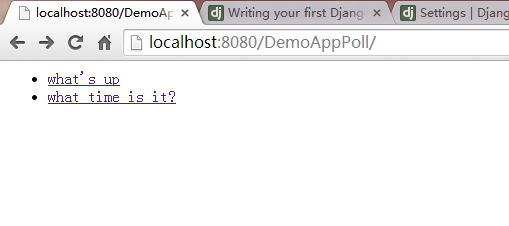
使用模版设计view的捷径:render()
常见的习惯是:加载模版,填充内容 ,返回HttpResponse.
Django 提供了一个简洁的方法来实现,例如上面的index()方法,
from django.shortcuts import render
#from django.http import HttpResponse
#from django.template import RequestContext, loader
from DemoAppPoll.models import Question
'''
def index(request):
# IMPORTANT: read db , order , limit
latest_question_list = Question.objects.order_by('-pub_date')[:5]
template = loader.get_template('DemoAppPoll/index.html')
context = RequestContext(
request,
{
'latest_question_list':latest_question_list,
},
)
return HttpResponse(template.render(context))
'''
# render(请求,模版,参数列表字典{key:value})
def index(request):
latest_question_list = Question.objects.order_by('-pub_date')[:5] @
context = {'latest_question_list': latest_question_list}
return render(request, 'DemoAppPoll/index.html', context)
注意到,"from django.shortcuts import render"之后,就不需要"from django.http import HttpResponse"和"from django.template import RequestContext, loader"
抛出异常404
在数据库里,如果只有2条记录,那么访问第3条记录,就应该抛出异常.
在DemoAppPoll/views.py
def detail(request, question_id):
try:
question = Question.objects.get(pk=question_id)
except Question.DoesNotExist:
raise Http404
return render(request, 'DemoAppPoll/detail.html', {'question': question})
#return HttpResponse("You're looking at question %s." % question_id)
注意
a.需要导入新包:
from django.http import Http404
b.需要创建模版文件:detail.html
<div align="center">
<table cellpadding="0" cellspacing="0" width="500">
<tr align="center" >
<td>question_id</td>
<td>question_text</td>
</tr>
<tr align="center">
<td >{{question_id}}</td>
<td >{{question}}</td>
</tr>
</table>
</div>
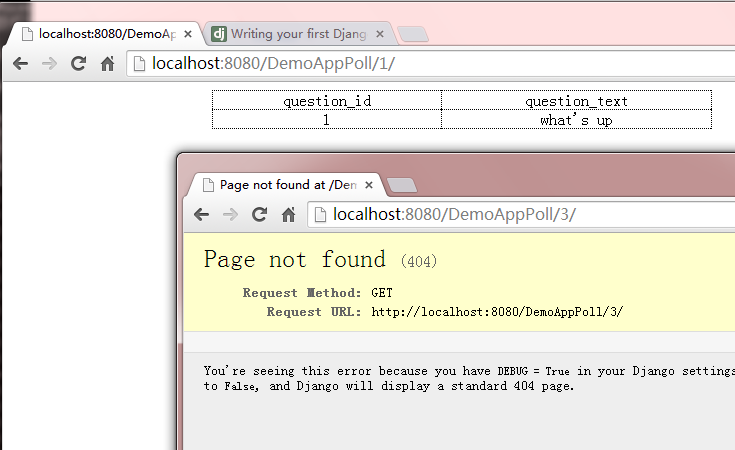
抛出异常404-快捷方法
在DemoAppPoll/views.py
'''
def detail(request, question_id):
try:
question = Question.objects.get(pk=question_id)
except Question.DoesNotExist:
raise Http404
return render(request, 'DemoAppPoll/detail.html', {'question': question,'question_id':question_id})
#return HttpResponse("You're looking at question %s." % question_id)
'''
def detail(request, question_id):
question = get_object_or_404(Question, pk=question_id)
return render(request, 'DemoAppPoll/detail.html', {'question': question})
这里,导入包的问题也存在,改为:
from django.shortcuts import render,get_object_or_404
多了个get_object_or_404.
question = get_object_or_404(Question, pk=question_id),得到对象
也有一个get_list_or_404() 函数,得到列表.
修改URL硬编码
在DemoAppPoll/templates/index.html中,url为硬编码.
li>{{ question.question_text }}
在DemoAppPoll/urls.py里,我们给这个url匹配指定过了名称(**name='detail'**)
```python
url(r'^(?P<question_id>d+)/$', views.detail, name='detail'),
可以使用{%url %}来生成url.
<li><a href="{% url 'detail' question.id %}">{{ question.question_text }}</a></li>
URL命名空间.
当多个app存在的时候,{%url%}指的是哪个?
可以在工程目录(demosite)下的urls.py中指定命名空间:
demoSite/urls.py
from django.conf.urls import patterns, include, url
from django.contrib import admin
urlpatterns = patterns('',
# url(r'^DemoAppPoll/', include('DemoAppPoll.urls')),
url(r'^DemoAppPoll/', include('DemoAppPoll.urls',namespace="DemoAppPoll")),
url(r'^admin/', include(admin.site.urls)),
)
这样,模版文件中,使用url名称的时候,需要指定命名空间:
DemoAppPoll/templates/DemoAppPoll/index.html
<li><a href="{% url 'DemoAppPoll:detail' question.id %}">{{ question.question_text }}</a></li>